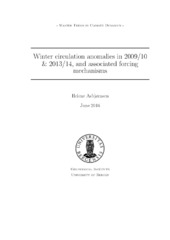Winter circulation anomalies in 2009/10 & 2013/14, and associated forcing mechanisms
Master thesis
Permanent lenke
https://hdl.handle.net/1956/12623Utgivelsesdato
2016-05-31Metadata
Vis full innførselSamlinger
- Geophysical Institute [1228]
Sammendrag
Recent cases of severe winter weather in midlatitude regions have been linked to large-scale atmospheric circulation anomalies, but the physical mechanisms driving such anomalies are poorly understood. In this study the circulation anomalies of two recent winters, 2009/10 and 2013/14, are investigated using a linear stationary wave model. As the model reproduces the observed atmospheric circulation of the two winters, it can be used to isolate and determine the effects of orographic features, diabatic heating patterns, transient eddies, and nonlinear interactions in forcing the anomalous circulation patterns. The results show that none of these forcing factors alone are responsible for the circulation anomalies seen in 2009/10 and 2013/14. Still, large parts of the anomaly fields are forced by diabatic heating, in combination with stationary nonlinear effects in 2009/10, and transient forcing in 2013/14. The diabatic heating response is thought to mainly originate from strong warm SST anomalies in the central tropical Pacific associated with an El Niño event in 2009/10, and moderate warm SST anomalies in the western tropical Pacific associated with a positive phase of the North Pacific mode in 2013/14. The different SST patterns generate slightly different circulation anomaly patterns the two winters. Eddy-mean flow interactions, and other processes where nonlinearity is important, contribute to enhance these differences, resulting in the contrasting circulation anomalies observed in 2009/10 compared to 2013/14.
